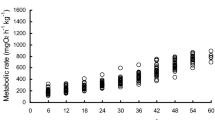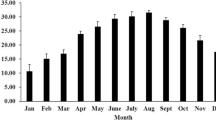Abstract
Atlantic cod populations live in a wide thermal range and can differ genetically and physiologically. Thermal sensitivity of metabolic capacity and swimming performance may vary along a latitudinal gradient, to facilitate performance in distinct thermal environments. To evaluate this hypothesis, we compared the thermal sensitivity of performance in two cod stocks from the Northwest Atlantic that differ in their thermal experience: Gulf of St Lawrence (GSL) and Bay of Fundy (BF). We first compared the metabolic, physiological and swimming performance after short-term thermal change to that at the acclimation temperature (7°C) for one stock (GSL), before comparing the performance of the two stocks after short-term thermal change. For cod from GSL, standard metabolism (SMR) increased with temperature, while active metabolism (AMR, measured in the critical swimming tests), EMR (metabolic rate after an exhaustive chase protocol), aerobic scope (AS) and critical swimming speeds (U crit and U b–c) were lower at 3°C than 7 or 11°C. In contrast, anaerobic swimming (sprint and burst-coasts in U crit test) was lower at 11 than 7 or 3°C. Factorial AS (AMR SMR−1) decreased as temperature rose. Time to exhaustion (chase protocol) was not influenced by temperature. The two stocks differed little in the thermal sensitivities of metabolism or swimming. GSL cod had a higher SMR than BF cod despite similar AMR and AS. This led factorial AS to be significantly higher for the southern stock. Despite these metabolic differences, cod from the two stocks did not differ in their U crit speeds. BF cod were better sprinters at both temperatures. Cod from GSL had a lower aerobic cost of swimming at intermediate speeds than those from BF, particularly at low temperature. Only the activity of cytochrome C oxidase (CCO) in white muscle differed between stocks. No enzymatic correlates were found for swimming capacities, but oxygen consumption was best correlated with CCO activity in the ventricle for both stocks. Overall, the stocks differed in their cost of maintenance, cost of transport and sprint capacity, while maintaining comparable thermal sensitivities.







Similar content being viewed by others
References
Arnott SA, Chiba S, Conover DO (2006) Evolution of intrinsic growth rate: metabolic costs drive trade-offs between growth and swimming performance in Menidia menidia. Evolution 60(6):1269–1278
Beacham TD, Brattey J, Miller KM, Le KD, Withler RE (2002) Multiple stock structure of Atlantic cod (Gadus morhua) off Newfoundland and Labrador determined from genetic variation. ICES J Mar Sci 59:650–665
Beamish FWH (1978) Swimming capacity. Fish Physiol 7:101–187
Bennett AF (1990) Thermal dependence of locomotor capacity. Am J Physiol 259:R253–R258
Billerbeck JM, Lankford TEJ, Conover DO (2001) Evolution of intrinsic growth and energy aquisition rates. I. Trade-offs with swimming performance in Menidia Menidia. Evolution 55(9):1863–1872
Biron M, Benfey TJ (1994) Cortisol, glucose and hematocrit chaqnges during acute stress, cohort sampling and the diel cycle in diploid and triploid trout (Salvelinus fontinalis Mitchilli). Fish Physiol Biochem 13:153–160
Boutilier RG (1998) Physiological ecology in cold ocean fisheries: a case study in Atlantic cod. In: Pörtner HO, Playle RC (eds) Cold ocean physiology. Cambridge University Press, Cambridge, pp 464–489
Brander KM (1995) The effect of temperature on growth of Atlantic cod (Gadus morhua L.) ICES J Mar Sci 52:1–10
Brett JR (1964) The respiratory metabolism and swimming performance of young sockeye salmon. Fish Res Board Canada 21(5):1183–1226
Bushnell PG, Steffensen JF, Schurmass H, Jones DR (1994) Exercise metabolism in two species of cod in Arctic waters. Polar Biol 14:43–48
Claireaux G, Webber DM, Kerr SR, Boutilier RG (1995) Physiology and behaviour of free-swimming Atlantic cod (Gadus morhua) facing fluctuating temperature conditions. J Exp Biol 198:49–60
Claireaux G, Webber DM, Lagardère JP, Kerr SR (2000) Influence of temperature and oxygenation on the aerobic metabolic scope of Atlantic cod (Gadus morhua). J Sea Res 44:257–265
Claireaux G, McKenzie DJ, Genge AG, Chatelier A, Aubin J (2005) Linking swimming performance, cardiac pumping ability and cardiac anatomy in rainbow trout. J Exp Biol 208:1775–1784
Conover DO, Present TMC (1990) Countergradient variation in growth rate: compensation for lengh of the growing season among Atlantic silversides from different latitudes. Oecologia 83:316–324
Couture P, Dutil J-D, Guderley H (1998) Biochemical correlates of growth and of condition in juvenile Atlantic cod (Gadus morhua) from Newfoundland. Can J Fish Aquat Sci 55:1591–1598
D’Amours D (1993) The distribution of cod (Gadus morhua) in relation to temperature and oxygen level in the Gulf of St. Lawrence. Fish Oceanogr 2:24–29
DFO (2004a) 2003 State of the ocean: physical oceanographic conditions on the Scotian Shelf, Bay of Fundy and Gulf of Maine. DFO Science Ecosystem Status Report 2004/002
DFO (2004b) 2003 State of the ocean: physical oceanographic conditions on the Gulf of St.Lawrence. DFO Science Ecosystem Status Report 2004/001
Dutil J-D, Brander KM (2003) Comparing productivity of North Atlantic cod (Gadus morhua) stocks and limits to growth production. Fish Oceanogr 12(4–5):502–512
Dutil J-D, Gauthier J, Lambert Y, Fréchet A, Chabot D (2003) Cod stocks rebuilding and fish bioenergetics: low productivity hypothesis. Canadian Advisory Secretariat Research Document 2003–060:60
Freedman LS, Pee D, Midthune DN (1992) The problem of underestimating the residual error variance in forward stepwise regression. Statistician 41:405–412
Godø OR, Michalsen K (2000) Migratory behaviour of north-east Arctic cod, studied by use of data storage tags. Fish Res Board Can 48:127–140
Guderley H (2004) Metabolic responses to low temperature in fish muscle. Biol Rev 79:409–427
Guderley H, Blier P (1988) Thermal acclimation in fish: conservative and labile properties of swimming muscle. Can J Zool 66:1105–1115
Hansen CA, Sidell BD (1983) Atlantic hagfish cardiac muscle: metabolic basis of tolerance to anoxia. Am J Physiol 244:R356–R362
Hochachka PW, Somero GN (2000) Biochemical adaptation. Press OU, editor. Oxford
ICES (2005) Spawning and life history information for North Atlantic cod stocks. Cooperative Research Report 274
Jabouin C (2005) Comparaison de la croissance en eau froide entre deux stocks de morue franche (Gadus morhua), vivant naturellement dans des environnements thermiques différents. MSc Thesis, UQAR
Jobling M (1988) A review of the physiological and nutritional energetics of cod, Gadus morhua L., with particular reference to growth under farmed conditions. Aquaculture 70:1–19
Johnson TP, Bennett AF, McLister JD (1996) Thermal dependence and acclimation of fast start locomotion and its physiological basis in rainbow trout (Oncorrhynchus mykiss). Physiol Zool 69(2):276–292
Lannig G, Eckerle LG, Serenderon I, Sartoris FJ, Fisher T, Knust R, Johansen T, Pörtner HO (2003) Temperature adaptation in eurythermal cod (Gadus morhua) a comparison of mitochondrial enzyme capacities in boreal and Arctic populations. Mar Biol 142:589–599
Lannig G, Storch D, Pörtner HO (2005) Aerobic mitochondrial capacities in Antarctic and temperate eelpout (Zoarcidae) subjected to warm versus cold acclimation. Polar Biol 28(8):575–584
Lapointe D (2004) Condition, sensibilité thermique, métabolisme et performance de nage chez la morue franche, Gadus morhua L. Université Laval, Québec
Lapointe D, Guderley H, Dutil JD (2006) Changes in the condition factor have an impact on metabolic rate and swimming performance relationships in Atlantic cod (Gadus morhua L.). Physiol Biochem Zool 79:109–119
Lear HW (1984) Atlantic cod. Underwater world: communication directorate, Department of Fisheries and Oceans, Ottawa, p 8
Levins R (1969) Thermal acclimation and heat resistance in Drosophila species. Am Nat 103:483–499
Levy EM, Cunningham CC, Conrad CDW, Moffat JD (1977) The determination of dissolved oxygen in sea water. Bedford Institute of Oceanography: Report Series 9
Martinez M, Bédard M, Dutil J-D, Guderley H (2004) Does condition of Atlantic cod (Gadus morhua) have a greater impact upon swimming performance at Ucrit or sprint speeds? J Exp Biol 207:2979–2990
Martinez M, Guderley H, Nelson JA, Webber D, Dutil J-D (2002) Once a fast cod, always a fast cod: maintenance of performance hierarchies despite changing food availability in cod (Gadus morhua). Physiol Biochem Zool 75:90–100
Nelson JA, Gotwalt PS, Reidy SP, Webber DM (2002) Beyond U crit: matching swimming performance tests to the physiological ecology of the animal, including new fish ‘drag strip’. Comp Biochem Physiol Part A 133:289–302
Nelson JA, Tang Y, Boutilier RG (1994) Differences in exercise physiology between two atlantic cod (Gadus morhua) populations from different environments. Physiol Zool 67(22):330–354
O’Steen S, Bennett AF (2003) Thermal acclimation effects differ between voluntary, maximum and critical swimming velocities in two cyprinid fishes. Physiol Biochem Zool 76(4):484–496
Pelletier D, Dutil J-D, Blier P, Guderley H (1994) Relation between growth rate and metabolic organization of white muscle, liver and digestive tract in cod, Gadus morhua. J Comp Physiol Part B 164:179–190
Pinz I, Poertner H-O (2003) Metabolic costs induced by lactate in the toad, Pufo marinus: new mechanism behind oxygen debt? J Appl Physiol 94:1177–1185
Pörtner HO (2002) Physiological basis of temperature-dependent biogeography: trade-offs in muscle design and performance in polar ectoterms. J Exp Biol 205:2217–2230
Pörtner HO, Berdal B, Blust R, Brix O, Colosimo A, De Wachter B, Giuliani A, Johansen T, Fischer T, Knust R et al (2001) Climate induced temperature effects on growth performance, fecundity and recruitment in marine fish: developing a hypothesis for cause and effect relationships in Atlantic cod (Gadus morhua) and common eelpout (Zoarces viviparus). Continental Shelf Res 21(18–19):1975–1997
Pörtner HO, Lucassen M, Storch D (2005) Metabolic biochemistry: its role in thermal tolerance and in the capacities of physiological and ecological function. Fish Physiol 22 (in press)
Purchase CF, Brown JA (2000) Interpopulation differences in growth rates and food conversion efficiencies of young Grand Banks and Gulf of Maine Atlantic cod (Gadus morhua). Can J Fish Aquat Sci 57:2223–2229
Purchase CF, Brown JA (2001) Stock-specific changes in growth rates, food conversion efficiencies, and energy allocation in response to temperature change in juvenile Atlantic cod. J Fish Biol 58(1):36–52
Reidy SP, Kerr SR, Nelson JA (2000) Aerobic and anaerobic swimming performance in individual Atlantic cod. J Exp Biol 203:347–357
Reidy SP, Nelson JA, Tang Y, Kerr SR (1995) Post-exercise metabolic rate in Atlantic cod and its dependence upon the method of exhaustion. J Fish Biol 47:377–386
Roche H, Bogé G (1996) Fish blood parameters as potential tools for identification of stress caused by environmental factors and chemical intoxication. Mar Environ Res 41:27–43
Rome LC, Loughna PT, Goldspink G (1984) Muscle fibre recruitment as a function of swim speed and muscle temperature in carp. Am J Physiol 247:R272–R279
Rome LC, Loughna PT, Goldspink G (1985) Temperature acclimation: improved sustained swimming performance at low temperature. Science 228:194–196
Ruzzante DE, Wroblewski JS, Taggart CT, Smedbol RK, Goddard SV (2000) Bay-scale population structure in coastal Atlantic cod in Labrador and Newfoundland, Canada. J Fish Biol 56(2):431–447
Saunders RL (1963) Respiration of the Atlantic cod. J Fish Res Board Can 20:373–385
Schurmann H, Steffensen JF (1994) Spontaneous swimming activity of Atlantic cod exposed to graded hypoxia at three temperatures. J Exp Biol 197:129–142
Schurmann H, Steffensen JF (1997) Effects of temperature, hypoxia and activity on the metabolism of juvenile Atlantic cod. J Fish Biol 50:1166–1180
Sidell BD, Driedzic WR, Stowe DB, Johnston IA (1987) Biochemical correlations of power development and metabolic fuel preferenda in fish hearts. Physiol Zool 60(2):221–232
Sundby S (2000) Recruitment of Atlantic cod stocks in relation to temperature and advection of copepod populations. Sarsia 85:277–298
Tang Y, Nelson JA, Reidy SP, Kerr SR, Boutilier RG (1994) A reappraisal of activity metabolism in Atlantic cod (Gadus morhua). J Fish Biol 44:1–10
Webb PW (1978) Hydrodynamique et énergétique de la propulsion des poissons. Ministère des pêches et Océans:190F
Webber DM, Boutilier RG, Kerr SR (1998) Cardiac output as predictor of metabolic rate in cod Gadus morhua. J Exp Biol 201:2779–2789
Acknowledgments
This study was supported by a grant from the Natural Sciences and Engineering Research Council to H.G., support from Quebec-Ocean to D.L. and E-L.S, and operating funds from DFO to J.-D.D. We would like to thank Sara McLean, François Tremblay, Richard Larocque, Lisane Gamache and Bernard Chénard for their excellent technical support at the Institute.
Author information
Authors and Affiliations
Corresponding author
Additional information
Communicated by H.V. Carey.
Rights and permissions
About this article
Cite this article
Sylvestre, EL., Lapointe, D., Dutil, JD. et al. Thermal sensitivity of metabolic rates and swimming performance in two latitudinally separated populations of cod, Gadus morhua L.. J Comp Physiol B 177, 447–460 (2007). https://doi.org/10.1007/s00360-007-0143-x
Received:
Revised:
Accepted:
Published:
Issue Date:
DOI: https://doi.org/10.1007/s00360-007-0143-x




